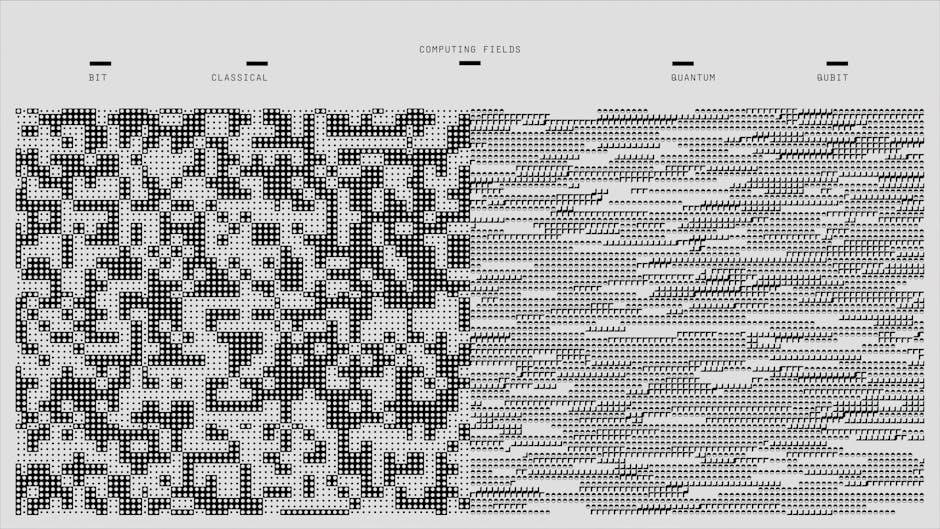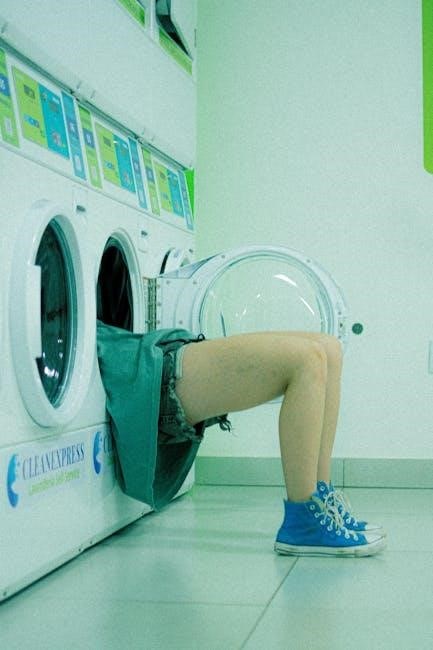GE washer fault codes are essential for diagnosing issues. This guide provides a comprehensive overview‚ helping users understand error messages and resolve problems efficiently using the official PDF list.
1.1 Importance of Understanding Fault Codes
Understanding GE washer fault codes is crucial for quick issue identification and resolution. These codes guide DIY troubleshooting‚ helping users address problems like clogged filters or sensor malfunctions. They prevent further damage by indicating when professional intervention is needed. Familiarity with error codes enhances maintenance routines and cost savings. Regularly reviewing the GE washer fault code list PDF ensures users can diagnose issues accurately‚ avoiding prolonged downtime and ensuring optimal appliance performance over time.
1.2 Overview of GE Washer Models
GE offers a wide range of washer models‚ from top-load to front-load designs‚ catering to various user needs. Models like GTW680‚ GFW850SPN2RS‚ and GTW330ASK3WW feature advanced technologies and varying capacities. Each model may have unique error codes‚ as seen in the GE washer fault code list PDF. Understanding your specific model’s design and features helps in effectively troubleshooting issues using the provided error codes‚ ensuring optimal performance and longevity of the appliance.

Common GE Washer Fault Codes
GE offers a variety of washer models‚ including top-load and front-load designs‚ catering to different user preferences and laundry needs. Models like GTW680‚ GFW850SPN2RS‚ and GTW330ASK3WW feature distinct technologies and capacities. Each model may have specific error codes detailed in the GE washer fault code list PDF‚ enabling precise troubleshooting and maintenance tailored to the appliance’s design.
2.1 Error Code 31: Motor Control Unit (MCU) Failure
Error Code 31 indicates a failure in the Motor Control Unit (MCU)‚ which regulates the washer’s motor operations. This code often appears due to power surges‚ worn-out components‚ or communication issues between the MCU and the control board. If unresolved‚ it can lead to complete system shutdown. Troubleshooting involves checking electrical connections and inspecting the MCU for damage. Referencing the GE washer fault code list PDF can provide detailed diagnostic steps and repair guidance for this specific issue.
2.2 Error Code 32: User Interface Control Failure
Error Code 32 signifies a failure in the user interface control‚ which manages the washer’s display and input functions. This issue often arises from faulty sensors‚ loose connections‚ or software glitches. Symptoms include unresponsive buttons‚ incorrect display readings‚ or intermittent functionality. Resetting the washer may temporarily resolve the issue‚ but persistent problems require professional inspection. The GE washer fault code list PDF provides detailed troubleshooting steps to address this specific control-related error effectively.
2.3 Error Code 33: Voltage Supply Issue
Error Code 33 indicates a voltage supply problem in your GE washer. This could stem from faulty electrical connections‚ a malfunctioning power supply module‚ or inconsistent voltage delivery. Symptoms include the washer failing to start or operate irregularly. Check the power cord and electrical outlets for issues. Resetting the washer might temporarily resolve the problem‚ but persistent errors may require professional inspection. The GE washer fault code list PDF provides detailed guidance for diagnosing and addressing voltage-related faults effectively.
2.4 Error Code 34: Water Temperature Sensor Malfunction
Error Code 34 signals a malfunction in the water temperature sensor of your GE washer. This sensor ensures accurate temperature readings during wash cycles. A faulty sensor may cause incorrect water temperatures‚ leading to inefficient washing or damage to clothes. Check for blockages or electrical issues with the sensor. Resetting the washer might temporarily fix the issue‚ but if the problem persists‚ replacing the sensor is recommended. The GE washer fault code list PDF offers detailed troubleshooting steps for this specific error‚ ensuring optimal appliance performance and preventing further malfunctions. Regular maintenance and inspections can help identify such issues early‚ reducing the need for costly repairs and extending the lifespan of your washer. By addressing Error Code 34 promptly‚ you can restore your washer’s functionality and maintain the quality of your laundry.

Troubleshooting GE Washer Error Codes
Troubleshooting GE washer errors involves checking codes‚ resetting the machine‚ and addressing common causes like clogged filters or sensor issues. Regular maintenance can prevent future problems.
3.1 Identifying the Error Code on the Display
Identifying the error code on your GE washer’s display is the first step in troubleshooting. Codes like 31‚ 32‚ or 18 indicate specific issues‚ such as MCU failure or a clogged pump filter. Referencing the official GE washer fault code list PDF helps decode these messages. Ensure the display is working correctly and the code is visible. This step is crucial for effective diagnosis and repair. Always verify the code against the official list for accuracy.
3.2 Resetting the Washer to Clear Error Codes
To reset your GE washer and clear error codes‚ start by unplugging it for 30 minutes to discharge any residual power. This simple step often resolves temporary glitches. If the issue persists‚ check your model’s specific reset procedure‚ which may involve pressing and holding buttons like Start/Stop or accessing diagnostic mode. Referencing the GE washer fault code list PDF or online guides can provide precise instructions. If the error reappears‚ professional assistance may be needed to address underlying issues.
3.3 Common Causes of Repeated Error Codes
Repeated error codes on your GE washer often indicate unresolved issues. Common causes include clogged pump filters‚ faulty sensors‚ or electrical malfunctions. Ignoring routine maintenance‚ like cleaning the filter or checking for worn parts‚ can lead to persistent problems. Additionally‚ power surges or incorrect installation may trigger recurring errors. Always consult the GE washer fault code list PDF for specific guidance‚ as some codes require professional attention to resolve effectively and prevent future occurrences.
Diagnostic Mode for GE Washers
Diagnostic mode helps identify issues by displaying specific error codes. Accessing this mode varies by model‚ often involving specific button combinations. Once activated‚ it provides detailed insights into malfunctions‚ guiding repairs. Refer to the GE washer fault code list PDF for instructions and code interpretations‚ ensuring accurate troubleshooting and maintenance for optimal appliance performance and longevity.
4.1 Accessing Diagnostic Mode
To access diagnostic mode on your GE washer‚ press and hold the Start/Stop button while turning the cycle selector knob to the Normal or Clean setting. Release the button and press it again to enter the mode. The display will show error codes if any are present. Refer to the official GE washer fault code list PDF for specific instructions‚ as the process may vary slightly depending on the model. This step is crucial for identifying and resolving issues efficiently.
4.2 Reading Error Codes in Diagnostic Mode
In diagnostic mode‚ the washer’s display will show error codes if any issues are detected. These codes‚ such as 18 or 27‚ correspond to specific problems outlined in the GE washer fault code list PDF. Use the PDF guide to interpret the codes accurately. The display may flash or show a combination of letters and numbers. Refer to the official manual or online resources for a detailed explanation of each code to ensure proper troubleshooting and repair. This step is vital for diagnosing and resolving issues effectively.
4.3 Using Diagnostic Mode for Advanced Troubleshooting
Diagnostic mode offers advanced tools for identifying and addressing complex issues. By activating this feature‚ users can access detailed error codes and perform test cycles to isolate problems. The GE washer fault code list PDF provides interpretations of these codes‚ enabling precise troubleshooting. Advanced users can test sensors‚ motors‚ and valves to pinpoint malfunctions. This mode is particularly useful for resolving persistent issues that basic troubleshooting steps cannot address‚ ensuring efficient repairs and restoring optimal performance. Regular use of diagnostic mode can also help prevent future issues by identifying early warning signs. For those unfamiliar with advanced diagnostics‚ consulting the PDF guide or a professional is recommended to avoid further complications. This step is crucial for maintaining the washer’s longevity and functionality. By leveraging diagnostic mode effectively‚ users can address both common and uncommon faults with confidence and accuracy.

GE Washer Error Code List PDF
The GE washer error code list PDF provides a comprehensive guide to understanding and resolving issues. It includes official codes‚ explanations‚ and troubleshooting steps for optimal appliance maintenance.
5.1 Finding the Official GE Washer Error Code List
To locate the official GE washer error code list‚ visit the GE Appliances website. Navigate to the support section‚ enter your model number‚ and download the corresponding PDF manual. This resource contains detailed explanations of each fault code‚ ensuring accurate troubleshooting and repair. Additionally‚ authorized dealers or customer support can provide access to the official guide‚ aiding in resolving issues efficiently.
5.2 Understanding the Structure of the PDF Guide
The official GE washer error code list PDF is structured for easy navigation. It typically includes alphabetical or numerical indexing of error codes‚ detailed descriptions‚ and troubleshooting steps. The guide may also feature diagrams or charts to illustrate complex issues. Each error code is paired with potential causes and solutions‚ helping users identify and address problems effectively. This clear organization ensures quick access to critical information‚ making DIY repairs more manageable.
5.3 Using the PDF Guide for Effective Troubleshooting
The GE washer fault code list PDF serves as a valuable tool for resolving issues efficiently. By referencing the error code displayed on the washer‚ users can quickly identify the problem and its likely cause. The guide provides step-by-step solutions‚ allowing homeowners to address issues independently. For instance‚ error code 18 indicates a clogged pump filter‚ guiding users to clean it. This resource empowers users to diagnose and fix problems‚ saving time and reducing the need for professional assistance.

Common Issues and Their Corresponding Codes
GE washers often display error codes like 18 (clogged pump filter)‚ 27 (drain pump failure)‚ and 35 (lid switch malfunction). These codes help identify specific issues quickly.
6.1 Error Code 18: Pump Filter Clogged
Error Code 18 indicates a clogged pump filter‚ a common issue in GE washers. This occurs when debris like lint or coins blocks the filter‚ disrupting water flow. Symptoms include poor drainage and wet clothes after cycles. To resolve‚ locate the pump filter (usually at the bottom)‚ remove debris‚ and rinse thoroughly. Regular cleaning prevents future occurrences and ensures optimal washer performance.
6.2 Error Code 27: Drain Pump Failure
Error Code 27 signifies a drain pump failure in GE washers; A failing pump can cause poor drainage‚ leading to wet clothes and potential leaks. Symptoms include unusual noises during drainage or incomplete water removal. Check for blockages in the pump or hoses. If issues persist‚ replacing the drain pump may be necessary. Regular maintenance‚ like cleaning the filter‚ can help prevent this error and ensure smooth operation.
6.3 Error Code 35: Lid Switch Malfunction
Error Code 35 indicates a lid switch malfunction in GE washers. The lid switch ensures the washer operates only when the lid is closed safely. If faulty‚ the washer may not start or cycle properly. Check for damage or misalignment of the lid or switch. Cleaning or replacing the switch may resolve the issue. This error highlights the importance of proper lid alignment and switch functionality for safe and efficient operation.

Maintenance Tips to Prevent Fault Codes
Regularly cleaning the pump filter and checking for worn parts can prevent common issues. Proper installation and ensuring good ventilation also help maintain optimal washer performance.
7.1 Regular Cleaning of the Pump Filter
Cleaning the pump filter regularly prevents clogs and ensures efficient drainage. Remove debris like lint‚ coins‚ and buttons to avoid error codes related to drainage issues. This simple maintenance task can prevent faults like error code 18‚ which signals a clogged pump filter. Regular cleaning also improves wash performance and prevents mold growth‚ keeping your washer running smoothly and prolonging its lifespan.
7.2 Checking and Replacing Worn-Out Parts
Regularly inspecting and replacing worn-out parts prevents recurring fault codes. Belts‚ hoses‚ and seals are prone to wear and tear‚ leading to issues like error code 27 (drain pump failure) or code 35 (lid switch malfunction). Replacing these components promptly ensures smooth operation. Always use genuine GE parts for reliability. Proper installation is crucial to avoid further damage. Regular inspections can help identify worn parts early‚ reducing the risk of unexpected breakdowns and costly repairs.
7.3 Ensuring Proper Ventilation and Installation
Proper ventilation and installation are critical to preventing GE washer fault codes. A well-ventilated area reduces moisture buildup‚ which can cause issues like error code 34 (water temperature sensor malfunction). Ensure the washer is installed on a level surface to avoid imbalance and vibration. Improper installation can lead to drainage problems‚ triggering codes like 18 (clogged pump filter). Always follow GE’s installation guidelines to maintain optimal performance and minimize the risk of recurring errors.

When to Call a Professional
Call a professional when fault codes indicate severe issues beyond DIY fixes‚ such as error code 31 or persistent problems after troubleshooting. Expert assistance ensures safety and proper repairs.
8.1 Recognizing Severe Fault Codes
Severe fault codes‚ such as 31 or 32‚ indicate critical failures like MCU or UI malfunctions. These require immediate professional attention to prevent further damage or safety hazards. Persistent issues‚ despite DIY efforts‚ also signal the need for expert intervention. Always refer to the official GE washer fault code list PDF to accurately identify and address such codes to avoid worsening the problem. Timely professional service ensures efficient and safe appliance operation.
8.2 Costs Associated with Professional Repairs
Professional repairs for GE washers vary in cost depending on the fault code and required fix. Severe issues like MCU failures or drain pump replacements can range from $200 to $600. Labor rates and parts costs are key factors. Diagnostic fees may apply‚ typically between $50 to $100. Always consult the official GE washer fault code list PDF to understand the issue before contacting a technician for an accurate repair quote.
8.3 Finding a Reliable GE Appliance Technician
To find a reliable GE appliance technician‚ start by visiting the Official GE Support Website for certified service providers. Check online reviews and ask for referrals to ensure expertise in GE models. Verify certifications and experience with GE washers. Compare quotes and ensure technicians specialize in your specific fault codes. A trusted technician will provide transparent diagnostics and reliable repairs‚ ensuring your washer operates efficiently after fixing the identified issues.

Future-Proofing Your GE Washer
Regular maintenance‚ software updates‚ and proper installation ensure optimal performance. Stay ahead of issues by following GE’s guidelines and updating firmware to prevent future faults and extend lifespan;
9.1 Regular Maintenance Schedules
Regular maintenance is key to preventing GE washer fault codes. Clean the pump filter monthly‚ check drain hoses for kinks‚ and ensure proper ventilation. Run diagnostic cycles periodically to identify potential issues early. Schedule professional inspections annually to address worn parts and software updates‚ ensuring your washer operates efficiently and prolongs its lifespan. Consistent upkeep helps avoid unexpected breakdowns and keeps your appliance running smoothly for years.
9.2 Upgrading to Smart Diagnostic Features
Upgrading to smart diagnostic features enhances your GE washer’s fault code detection. Modern models offer real-time monitoring through smartphone apps‚ enabling early issue identification. These systems provide detailed error explanations and repair guidance‚ reducing guesswork. Smart diagnostics also automatically update firmware‚ ensuring optimal performance. By integrating advanced technology‚ you can address problems promptly‚ minimizing downtime and extending your washer’s lifespan. This proactive approach streamlines maintenance and enhances overall appliance efficiency.
9.3 Staying Updated with Firmware and Software
Regularly updating your GE washer’s firmware and software ensures optimal performance and error code management. These updates often include enhancements for fault detection and troubleshooting. By staying current‚ you gain access to the latest diagnostic tools and improved compatibility with smart features. Always check the official GE website or support resources for the most recent updates. Periodically verifying and installing new versions helps maintain your washer’s efficiency and reduces the likelihood of unresolved issues.

Additional Resources for GE Washer Owners
Official GE support websites‚ community forums‚ and video tutorials provide valuable resources for troubleshooting and repair. These tools help owners resolve issues and maintain their washers effectively.
10.1 Official GE Support Website
The Official GE Support Website is a primary resource for washer owners‚ offering detailed fault code lists‚ repair guides‚ and troubleshooting tips. Users can download the GE Washer Fault Code List PDF directly‚ ensuring access to accurate diagnostic information. The site also provides warranty details‚ maintenance advice‚ and links to certified repair services. It’s a one-stop solution for resolving issues and understanding error codes‚ helping users maintain their appliances effectively.
10.2 Community Forums and User Guides
Community forums and user guides offer valuable insights and real-life solutions for GE washer issues. Many forums discuss common fault codes‚ such as error code 18 and 31‚ sharing DIY fixes and repair experiences. These platforms complement the official GE Washer Fault Code List PDF by providing practical advice from users who’ve resolved similar problems. They also include troubleshooting tips and part recommendations‚ helping users address issues efficiently and cost-effectively.
10.3 Video Tutorials for DIY Repairs
Video tutorials provide step-by-step visual guidance for diagnosing and repairing GE washer issues. Platforms like YouTube offer tutorials covering common fault codes‚ such as error code 31 and 18‚ helping users understand and resolve problems. These videos often include practical tips‚ such as cleaning the pump filter or resetting the washer‚ and are especially useful for those who prefer hands-on learning. They complement the official GE Washer Fault Code List PDF by offering real-time demonstrations and DIY solutions.
Understanding GE washer fault codes empowers users to diagnose and resolve issues efficiently. Regular maintenance and referencing the official PDF guide ensure optimal performance and longevity of your appliance.
11.1 Summary of Key Takeaways
Understanding GE washer fault codes is crucial for effective troubleshooting. Referencing the official PDF guide provides detailed insights into error codes‚ enabling timely repairs. Regular maintenance‚ such as cleaning filters and checking sensors‚ prevents recurring issues. Knowing when to call a professional ensures severe faults are addressed safely. By staying proactive and informed‚ users can extend their washer’s lifespan and maintain optimal performance. This guide equips you with the tools to diagnose and resolve problems confidently.
11.2 Encouragement for Proactive Maintenance
Proactive maintenance is key to extending your GE washer’s lifespan. Regularly cleaning filters‚ checking sensors‚ and ensuring proper installation prevents fault codes. Staying updated with firmware and referring to the official PDF guide empowers you to address issues early. By prioritizing routine care‚ you avoid costly repairs and ensure consistent performance. Adopting these habits fosters a reliable and efficient washing machine‚ saving time and money in the long run. Consistency is the cornerstone of appliance longevity;

References
Refer to the official GE washer fault code list PDF for detailed troubleshooting. Visit the GE support website for manuals and authorized repair services. Links to official resources ensure accurate diagnostics and repairs.
12.1 Links to Official GE Washer Manuals
The official GE washer manuals provide comprehensive guides for troubleshooting and repairs. Visit the GE Appliances website to download the latest PDF manuals specific to your model. These resources include detailed error code lists‚ diagnostic procedures‚ and repair instructions. Ensure you refer to the correct manual for accurate information‚ as models may vary. Using official guides helps in addressing issues effectively and safely. Always verify the source for reliability.
12.2 Recommended Repair Services and Tools
For reliable repairs‚ consider authorized GE service providers who use genuine parts. Avoid unauthorized services to maintain warranty and safety. Essential tools include multimeters‚ screwdriver sets‚ and diagnostic kits. Ensure you have a GE-specific toolkit for compatibility. DIY enthusiasts can find detailed guides and recommended tools on GE’s official website or trusted appliance repair forums. Always prioritize safety and proper diagnostics to avoid further damage. Regular maintenance tools can also prevent future faults;
